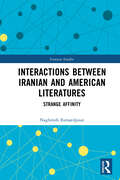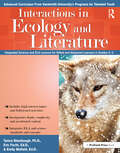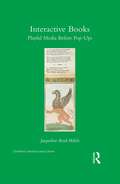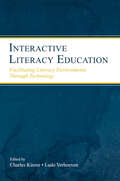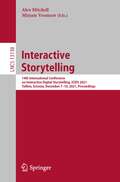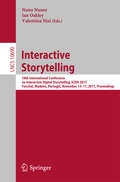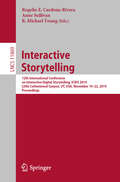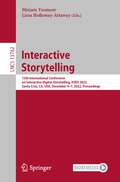- Table View
- List View
The Interactional Instinct: The Evolution and Acquisition of Language
by John H. Schumann Namhee Lee Anna Dina Joaquin Lisa Mikesell Andrea W. MatesThe Interactional Instinct explores the evolution of language from the theoretical view that language could have emerged without a biologically instantiated Universal Grammar. In the first part of the book, the authors speculate that a hominid group with a lexicon of about 600 words could combine these items to make larger meanings. Combinations that are successfully produced, comprehended, and learned become part of the language. Any combination that is incompatible with human mental capacities is abandoned. The authors argue for the emergence of language structure through interaction constrained by human psychology and physiology. In the second part of the book, the authors argue that language acquisition is based on an "interactional instinct" that emotionally entrains the infant on caregivers. This relationship provides children with a motivational and attentional mechanism that ensures their acquisition of language. In adult second language acquisition, the interactional instinct is no longer operating, but in some individuals with sufficient aptitude and motivation, successful second-language acquisition can be achieved. The Interactional Instinct presents a theory of language based on linguistic, evolutionary, and biological evidence indicating that language is a culturally inherited artifact that requires no a priori hard wiring of linguistic knowledge.
Interactions Between Iranian and American Literatures: Strange Affinity (Iranian Studies)
by Naghmeh EsmaeilpourIntroducing "narrative mobility" as a new approach in comparative studies of Iran and the US, this book reinterprets the politics and aesthetics of relations between the nations through an analysis of Iranian and American authors.The book focuses specifically on three authors—Simin Daneshvar, Shahriar Mandanipour, and Don DeLillo—who each employ narrative mobility to rethink intercultural negotiation, addressing parallel issues in America and Iran from different, but complementary, perspectives. The book analyzes the employment of parallel narrational techniques, presenting physically and virtually mobile characters who embody their respective countries as they move from one culture to another. The strange affinity between Iran and the US is ultimately revealed by viewing literary works as a "contact zone" through which the complicated relations and shared history of the two nations can be renegotiated. On a more theoretical level, the book reflects on the role of literature—in particular the novel as a transnational medium—as a bridge between nations in a period of globalization.With its focus on cross-cultural connections, the book will be of interest to anyone studying or researching comparative literature, US–Iran relations, and cultural studies generally.
Interactions Between Iranian and American Literatures: Strange Affinity (Iranian Studies)
by Naghmeh EsmaeilpourIntroducing "narrative mobility" as a new approach in comparative studies of Iran and the US, this book reinterprets the politics and aesthetics of relations between the nations through an analysis of Iranian and American authors.The book focuses specifically on three authors—Simin Daneshvar, Shahriar Mandanipour, and Don DeLillo—who each employ narrative mobility to rethink intercultural negotiation, addressing parallel issues in America and Iran from different, but complementary, perspectives. The book analyzes the employment of parallel narrational techniques, presenting physically and virtually mobile characters who embody their respective countries as they move from one culture to another. The strange affinity between Iran and the US is ultimately revealed by viewing literary works as a "contact zone" through which the complicated relations and shared history of the two nations can be renegotiated. On a more theoretical level, the book reflects on the role of literature—in particular the novel as a transnational medium—as a bridge between nations in a period of globalization.With its focus on cross-cultural connections, the book will be of interest to anyone studying or researching comparative literature, US–Iran relations, and cultural studies generally.
Interactions between Orality and Writing in Early Modern Italian Culture
by Brian Richardson Chiara Sbordoni Luca Degl'InnocentiInvestigating the interrelationships between orality and writing in elite and popular textual culture in early modern Italy, this volume shows how the spoken or sung word on the one hand, and manuscript or print on the other hand, could have interdependent or complementary roles to play in the creation and circulation of texts. The first part of the book centres on performances, ranging from realizations of written texts to improvisations or semi-improvisations that might draw on written sources and might later be committed to paper. Case studies examine the poems sung in the piazza that narrated contemporary warfare, commedia dell'arte scenarios, and the performative representation of the diverse spoken languages of Italy. The second group of essays studies the influence of speech on the written word and reveals that, as fourteenth-century Tuscan became accepted as a literary standard, contemporary non-standard spoken languages were seen to possess an immediacy that made them an effective resource within certain kinds of written communication. The third part considers the roles of orality in the worlds of the learned and of learning. The book as a whole demonstrates that the borderline between orality and writing was highly permeable and that the culture of the period, with its continued reliance on orality alongside writing, was often hybrid in nature.
Interactions between Orality and Writing in Early Modern Italian Culture
by Brian Richardson Chiara Sbordoni Luca Degl’innocentiInvestigating the interrelationships between orality and writing in elite and popular textual culture in early modern Italy, this volume shows how the spoken or sung word on the one hand, and manuscript or print on the other hand, could have interdependent or complementary roles to play in the creation and circulation of texts. The first part of the book centres on performances, ranging from realizations of written texts to improvisations or semi-improvisations that might draw on written sources and might later be committed to paper. Case studies examine the poems sung in the piazza that narrated contemporary warfare, commedia dell'arte scenarios, and the performative representation of the diverse spoken languages of Italy. The second group of essays studies the influence of speech on the written word and reveals that, as fourteenth-century Tuscan became accepted as a literary standard, contemporary non-standard spoken languages were seen to possess an immediacy that made them an effective resource within certain kinds of written communication. The third part considers the roles of orality in the worlds of the learned and of learning. The book as a whole demonstrates that the borderline between orality and writing was highly permeable and that the culture of the period, with its continued reliance on orality alongside writing, was often hybrid in nature.
Interactions in Ecology and Literature: Integrated Science and ELA Lessons for Gifted and Advanced Learners in Grades 2-3
by Tamra Stambaugh Emily Mofield Eric FechtWinner of the 2015 NAGC Curriculum Studies Award Interactions in Ecology and Literature integrates ecology with the concept of interactions and the reading of fictional and informational texts. This unit, developed by Vanderbilt University's Programs for Talented Youth, is aligned to the Common Core State Standards for English Language Arts and Next Generation Science Standards. Students will research questions such as "Should animals be kept in zoos?" and "Should humans intervene to control overpopulation of species?" They will examine relationships among living things and the environment as well as relationships between literary elements in texts through accelerated content, engaging activities, and differentiated tasks. Ideal for gifted classrooms or gifted pull-out groups, the unit features fictional texts from Lynne Cherry, Katherine Applegate, and Jacqueline Woodson; art from Mark Rothko and Georges Seurat; informational texts about deforestation and a variety of animals; biographies about Michael Jordan, J. K. Rowling, and Walt Disney; and videos about food chains, food webs, and more. Grades 2-3
Interactions in Ecology and Literature: Integrated Science and ELA Lessons for Gifted and Advanced Learners in Grades 2-3
by Tamra Stambaugh Emily Mofield Eric FechtWinner of the 2015 NAGC Curriculum Studies Award Interactions in Ecology and Literature integrates ecology with the concept of interactions and the reading of fictional and informational texts. This unit, developed by Vanderbilt University's Programs for Talented Youth, is aligned to the Common Core State Standards for English Language Arts and Next Generation Science Standards. Students will research questions such as "Should animals be kept in zoos?" and "Should humans intervene to control overpopulation of species?" They will examine relationships among living things and the environment as well as relationships between literary elements in texts through accelerated content, engaging activities, and differentiated tasks. Ideal for gifted classrooms or gifted pull-out groups, the unit features fictional texts from Lynne Cherry, Katherine Applegate, and Jacqueline Woodson; art from Mark Rothko and Georges Seurat; informational texts about deforestation and a variety of animals; biographies about Michael Jordan, J. K. Rowling, and Walt Disney; and videos about food chains, food webs, and more. Grades 2-3
Interactive Books: Playful Media before Pop-Ups (Children's Literature and Culture)
by Jacqueline Reid-WalshMovable books are an innovative area of children’s publishing. Commonly equated with spectacular pop-ups, movable books have a little-known history as interactive, narrative media. Since they are hybrid artifacts consisting of words, images and movable components, they cross the borders between story, toy, and game. Interactive Books is a historical and comparative study of early movable books in relation to the children who engage with them. Jacqueline Reid-Walsh focuses on the period movable books became connected with children from the mid-17th to the early-19th centuries. In particular, she examines turn-up books, paper doll books, and related hybrid experiments like toy theaters and paignion (or domestic play set) produced between 1650 and 1830. Despite being popular in their own time, these artifacts are little known today. This study draws attention to a gap in our knowledge of children’s print culture by showing how these artifacts are important in their own right. Reid-Walsh combines archival research with children’s literature studies, book history, and juvenilia studies. By examining commercially produced and homemade examples, she explores the interrelations among children, interactive media, and historical participatory culture. By drawing on both Enlightenment thinkers and contemporary digital media theorists Interactive Books enables us to think critically about children’s media texts paper and digital, past and present.
Interactive Books: Playful Media before Pop-Ups (Children's Literature and Culture)
by Jacqueline Reid-WalshMovable books are an innovative area of children’s publishing. Commonly equated with spectacular pop-ups, movable books have a little-known history as interactive, narrative media. Since they are hybrid artifacts consisting of words, images and movable components, they cross the borders between story, toy, and game. Interactive Books is a historical and comparative study of early movable books in relation to the children who engage with them. Jacqueline Reid-Walsh focuses on the period movable books became connected with children from the mid-17th to the early-19th centuries. In particular, she examines turn-up books, paper doll books, and related hybrid experiments like toy theaters and paignion (or domestic play set) produced between 1650 and 1830. Despite being popular in their own time, these artifacts are little known today. This study draws attention to a gap in our knowledge of children’s print culture by showing how these artifacts are important in their own right. Reid-Walsh combines archival research with children’s literature studies, book history, and juvenilia studies. By examining commercially produced and homemade examples, she explores the interrelations among children, interactive media, and historical participatory culture. By drawing on both Enlightenment thinkers and contemporary digital media theorists Interactive Books enables us to think critically about children’s media texts paper and digital, past and present.
Interactive Fictions: Scenes of Storytelling in the Novel (Contributions to the Study of World Literature)
by Yael Halevi-WiseArguing that genre must play a role in our study of narrative fiction, this tour of the novel examines interactive storytelling scenes in which characters argue about how to tell a tale that meets their respective social and aesthetic expectations. Through intense readings of interactive storytelling scenes in works spanning the 17th through 20th centuries, Halevi-Wise demonstrates how dramatized arguments about storytelling open a window on social and generic dilemmas affecting the narrative of each novel at the time of its composition. Examined in detail are Cervantes' Don Quixote, Sterne's Tristam Shandy, Austen's Northanger Abbey, Dickens's Little Dorrit, Conrad's Lord Jim, Yehoshua's Mr. Mani, and Esquivel'sI Like Water for Chocolate.Redressing an imbalance between sociological approaches that displace aesthetic considerations and aesthetic analyses that bracket cultural phenomena, the author shows why both genre and culture must be taken into account when we analyze the formation and reception of a narrative. Each interactive storytelling event illustrates how social and aesthetic interests compete and reinvent themselves within their framing texts and those texts' respective national and historical contexts. Just as social interactions cannot be indefinitely displaced in the study of narrative fiction, genre cannot be ignored in the study of identity politics. What emerges from this unique examination is a postmodern poetics of the novel that takes genre and history into account.
Interactive Literacy Education: Facilitating Literacy Environments Through Technology
by Charles Kinzer Ludo VerhoevenInteractive Literacy Education combines the latest research and theory related to technology-based instructional design for children’s literacy development. It shows how technology can be used to build literacy learning environments that are compatible with students’ cognitive and social processes. Topics addressed throughout this enlightening work include:*technology environments and applications that preservice teachers can use with young children;*detailed information regarding the development and implementation of specific technological programs; and*various technologies, from interactive reading and spelling programs to speech recognition to multimedia, that teachers can use to enhance their literacy learning environments. Interactive Literacy Education is intended for graduate courses in methods of literacy instruction; educational technology; curriculum/curriculum design; general preservice education; special education; and applied psychology/cognitive studies. It is also appropriate for use as a supplement in undergraduate courses in methods of literacy instruction and educational technology.
Interactive Literacy Education: Facilitating Literacy Environments Through Technology
Interactive Literacy Education combines the latest research and theory related to technology-based instructional design for children’s literacy development. It shows how technology can be used to build literacy learning environments that are compatible with students’ cognitive and social processes. Topics addressed throughout this enlightening work include:*technology environments and applications that preservice teachers can use with young children;*detailed information regarding the development and implementation of specific technological programs; and*various technologies, from interactive reading and spelling programs to speech recognition to multimedia, that teachers can use to enhance their literacy learning environments. Interactive Literacy Education is intended for graduate courses in methods of literacy instruction; educational technology; curriculum/curriculum design; general preservice education; special education; and applied psychology/cognitive studies. It is also appropriate for use as a supplement in undergraduate courses in methods of literacy instruction and educational technology.
Interactive Oral History Interviewing (Routledge Communication Series)
by Eva M. McMahan Kim Lacy RogersThe essays in this anthology represent, in the broadest sense, an interpretive perspective of inquiry that has flourished in oral history for the past 15 years. This perspective considers oral history interviews as subjective, socially constructed and emergent events; that is, understanding, interpretation, and meaning of lived experience are interactively constructed. The impetus for this volume was the editor's fascination with the multifaceted complexity of the oral history interview method coupled with the belief that, despite many books that address methodological issues, no single work takes as its focus those complex, interactive processes which constitute the oral history interview. The editors' purpose in developing this anthology, therefore, was to provide a variety of essays which taken together address the possibilities and constraints inherent in oral history interviewing.
Interactive Oral History Interviewing: Interactive Oral History Interviewing (Routledge Communication Series)
by Eva M. McMahan Kim Lacy RogersThe essays in this anthology represent, in the broadest sense, an interpretive perspective of inquiry that has flourished in oral history for the past 15 years. This perspective considers oral history interviews as subjective, socially constructed and emergent events; that is, understanding, interpretation, and meaning of lived experience are interactively constructed. The impetus for this volume was the editor's fascination with the multifaceted complexity of the oral history interview method coupled with the belief that, despite many books that address methodological issues, no single work takes as its focus those complex, interactive processes which constitute the oral history interview. The editors' purpose in developing this anthology, therefore, was to provide a variety of essays which taken together address the possibilities and constraints inherent in oral history interviewing.
Interactive Storytelling: 14th International Conference on Interactive Digital Storytelling, ICIDS 2021, Tallinn, Estonia, December 7–10, 2021, Proceedings (Lecture Notes in Computer Science #13138)
by Alex Mitchell Mirjam VosmeerThis book constitutes the refereed proceedings of the 14th International Conference on Interactive Digital Storytelling, ICIDS 2021, held in Tallinn, Estonia, in December 2021. The 18 full papers and 17 short papers, presented together with 17 posters and demos, were carefully reviewed and selected from 99 submissions. The papers are categorized into the following topical sub-headings: Narrative Systems; Interactive Narrative Theory; Interactive Narrative Impact and Application; and the Interactive Narrative Research Discipline and Contemporary Practice.
Interactive Storytelling: 9th International Conference on Interactive Digital Storytelling, ICIDS 2016, Los Angeles, CA, USA, November 15–18, 2016, Proceedings (Lecture Notes in Computer Science #10045)
by Frank Nack Andrew S. GordonThis book constitutes the refereed proceedings of the 9th International Conference on Interactive Digital Storytelling, ICIDS 2016, held in Los Angeles, CA, USA, in November 2016. The 26 revised full papers and 8 short papers presented together with 9 posters, 4 workshop, and 3 demonstration papers were carefully reviewed and selected from 88 submissions. The papers are organized in topical sections on analyses and evaluation systems; brave new ideas; intelligent narrative technologies; theoretical foundations; and usage scenarios and applications.
Interactive Storytelling: 10th International Conference on Interactive Digital Storytelling, ICIDS 2017 Funchal, Madeira, Portugal, November 14–17, 2017, Proceedings (Lecture Notes in Computer Science #10690)
by Nuno Nunes, Ian Oakley and Valentina NisiThis book constitutes the refereed proceedings of the 10th International Conference on Interactive Digital Storytelling, ICIDS 2017, held in Funchal, Madeira, Portugal, in November 2017. The 16 revised full papers and 4 short papers presented were carefully reviewed and selected from 65 submissions. The papers are organized in topical sections on story design, location and generation, history and learning, games, emotion and personality, posters and demos.
Interactive Storytelling: A Cross-Media Approach to Writing, Producing and Editing with AI
by Antonio Pizzo Vincenzo Lombardo Rossana DamianoTaking a cross-media approach to the ever-changing field of digital storytelling, this book offers an essential introduction to producing and editing interactive storytelling content, and to the platforms that host it. Merging algorithmic and AI approaches with basic writing technique, the authors begin by providing a brief history of the field before moving on to practical step-by-step guides on techniques, models and software architectures. Examples and exercises are drawn from free-to-access, purpose-built software created by the authors as well as exemplary interactive storytelling work. Assuming the perspective of the storyteller and focusing on elements shared across different fields of professional communication, the book is designed to be a primer for digital communicators, irrespective of the medium they are working with. As such, the methods provided will be applicable across the spectrum of TV, film, videogames, web and mobile storytelling. Interactive Storytelling is recommended reading for professionals as well as advanced undergraduate and postgraduate students of interactive entertainment, multimedia design and production, and digital journalism.
Interactive Storytelling: A Cross-Media Approach to Writing, Producing and Editing with AI
by Antonio Pizzo Vincenzo Lombardo Rossana DamianoTaking a cross-media approach to the ever-changing field of digital storytelling, this book offers an essential introduction to producing and editing interactive storytelling content, and to the platforms that host it. Merging algorithmic and AI approaches with basic writing technique, the authors begin by providing a brief history of the field before moving on to practical step-by-step guides on techniques, models and software architectures. Examples and exercises are drawn from free-to-access, purpose-built software created by the authors as well as exemplary interactive storytelling work. Assuming the perspective of the storyteller and focusing on elements shared across different fields of professional communication, the book is designed to be a primer for digital communicators, irrespective of the medium they are working with. As such, the methods provided will be applicable across the spectrum of TV, film, videogames, web and mobile storytelling. Interactive Storytelling is recommended reading for professionals as well as advanced undergraduate and postgraduate students of interactive entertainment, multimedia design and production, and digital journalism.
Interactive Storytelling: 12th International Conference on Interactive Digital Storytelling, ICIDS 2019, Little Cottonwood Canyon, UT, USA, November 19–22, 2019, Proceedings (Lecture Notes in Computer Science #11869)
by Rogelio E. Cardona-Rivera Anne Sullivan R. Michael YoungThis book constitutes the refereed proceedings of the 12th International Conference on Interactive Digital Storytelling, ICIDS 2019, held in Little Cottonwood Canyon, UT, USA, in November 2019. The 14 revised full papers and 10 short papers presented together with 19 posters, 1 demo, and 3 doctoral consortiums were carefully reviewed and selected from 66 submissions. The papers are organized in the following topical sections: Creating the Discipline: Interactive Digital Narrative Studies, Impacting Culture and Society, Interactive Digital Narrative Practices and Applications, Theoretical Foundations, Technologies, Human Factors, Doctoral Consortium, and Demonstrations.
Interactive Storytelling: 11th International Conference on Interactive Digital Storytelling, ICIDS 2018, Dublin, Ireland, December 5–8, 2018, Proceedings (Lecture Notes in Computer Science #11318)
by Rebecca Rouse Hartmut Koenitz Mads HaahrThis book constitutes the refereed proceedings of the 11th International Conference on Interactive Digital Storytelling, ICIDS 2018, held in Dublin, Ireland, in December 2018. The 20 revised full papers and 16 short papers presented together with 17 posters, 11 demos, and 4 workshops were carefully reviewed and selected from 56, respectively 29, submissions. The papers are organized in the following topical sections: the future of the discipline; theory and analysis; practices and games; virtual reality; theater and performance; generative and assistive tools and techniques; development and analysis of authoring tools; and impact in culture and society.
Interactive Storytelling: 15th International Conference on Interactive Digital Storytelling, ICIDS 2022, Santa Cruz, CA, USA, December 4–7, 2022, Proceedings (Lecture Notes in Computer Science #13762)
by Mirjam Vosmeer Lissa Holloway-AttawayThis book constitutes the refereed proceedings of the 15th International Conference on Interactive Digital Storytelling, ICIDS 2022, held in Santa Cruz, CA, USA, in December 2022.The 30 full papers and 10 short papers, presented together with 17 posters and demos, were carefully reviewed and selected from 79 submissions.
Interactive Tasks (The Routledge E-Modules on Contemporary Language Teaching)
by Michael Leeser Justin WhiteThis module on interactive tasks provides teachers with an overview of the nature of communication and explores the ways in which interactive tasks can promote communicative exchanges among students and teachers. The module provides guidelines for developing tasks, along with examples and options for their use in various types of language courses, including beginning level language classes, as well as more advanced language courses focusing culture, linguistics, literature, and film. Please visit the series companion website for more information: http://routledgetextbooks.com/textbooks/9781315679594/
Interactive Tasks (The Routledge E-Modules on Contemporary Language Teaching)
by Michael Leeser Justin WhiteThis module on interactive tasks provides teachers with an overview of the nature of communication and explores the ways in which interactive tasks can promote communicative exchanges among students and teachers. The module provides guidelines for developing tasks, along with examples and options for their use in various types of language courses, including beginning level language classes, as well as more advanced language courses focusing culture, linguistics, literature, and film. Please visit the series companion website for more information: http://routledgetextbooks.com/textbooks/9781315679594/
Interactive TV Standards: A Guide to MHP, OCAP, and JavaTV
by Steven Morris Anthony Smith-ChaigneauFor any digital TV developer or manager, the maze of standards and specifications related to MHP and OCAP is daunting-you have to patch together pieces from several standards to gather all the necessary knowledge you need to compete worldwide. The standards themselves can be confusing, and contain many inconsistencies and missing pieces. Interactive TV Standards provides a guide for actually deploying these technologies for a broadcaster or product and application developer. Understanding what the APIs do is essential for your job, but understanding how the APIs work and how they relate to each other at a deeper level helps you do it better, faster and easier. Learn how to spot when something that looks like a good solution to a problem really isn't. Understand how the many standards that make up MHP fit together, and implement them effectively and quickly. Two DVB insiders teach you which elements of the standards that are needed for digital TV, highlight those elements that are not needed, and explain the special requirements that MHP places on implementations of these standards.Once you've mastered the basics, you will learn how to develop products for US, European, and Asian markets--saving time and money. By detailing how a team can develop products for both the OCAP and MHP markets, Interactive TV Standards teaches you how to to leverage your experience with one of these standards into the skills and knowledge needed to work with the critical, related standards.Does the team developing a receiver have all the knowledge they need to succeed, or have they missed important information in an apparently unrelated standard? Does an application developer really know how to write a reliable piece of software that runs on any MHP or OCAP receiver? Does the broadcaster understand the business and technical issues well enough to deploy MHP successfully, or will their project fail? Increase your chances of success the first time with Interactive TV Standards.

